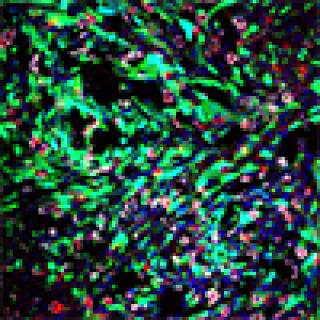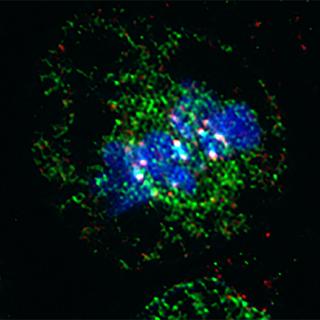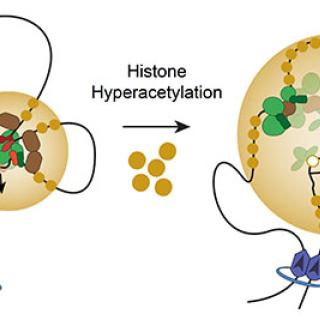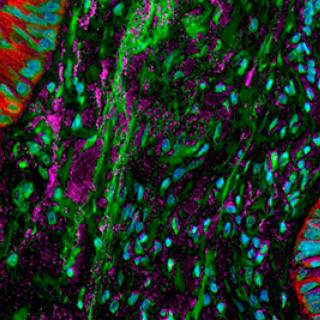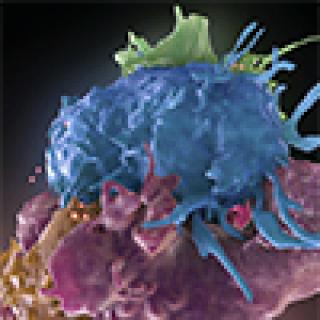News and Events
Proteins Released from the Nuclei of Dying Cancer Cells Promote Tumor Growth
Material released from dying cancer cells, known as tumor cell nuclear expulsion products (TuNEPs), contains specific proteins that promote the growth of neighboring cancer cells. Targeting these proteins could lead to new treatments that hinder cancer spread and improve patient outcomes.
Read MoreFDA grants orphan drug designation to zotiraciclib for the treatment of glioma
The U.S. Food and Drug Administration granted orphan drug status in December to zotiraciclib for use in patients with glioma, a cancer of the brain that begins in glial cells (cells that surround and support nerve cells). This designation is based on results from an ongoing NCI-sponsored phase 1 trial led by the CCR Neuro-Oncology Branch at the NIH Clinical Center.
Read MoreProtein affecting cell division hints at a way to overcome drug resistance
Researchers have uncovered the way in which a protein, called CLR4, helps complete the cell division process. The mechanism could potentially be harnessed to overcome resistance of cancer cells to chemotherapy drugs such as paclitaxel.
Read MoreJay Berzofsky and Hoyoung Maeng discuss new vaccine to help men with prostate cancer
Jay Berzofsky, M.D., Ph.D., Chief of the Vaccine Branch, and Hoyoung Maeng, M.D., Assistant Research Physician in the Vaccine Branch, recently discussed their ongoing work to design and develop vaccines and immunotherapy for cancer prevention and treatment with Cancer Therapy Advisor. They share how they are testing a vaccine that may one day delay the need to use androgen deprivation therapy (ADT) in prostate cancer patients.
Read MoreFormer Pediatric Oncology Branch patient donates toys to NIH Pediatric Clinic
In December, former patient Julie Jones donated over 1,000 toys to the Pediatric Clinic at the NIH Clinical Center. Jones is a former patient in the Pediatric Oncology Branch who was treated more than 20 years ago for alveolar rhabdomyosarcoma. She says, “I remember what it was like. What these children are going through at such a young age really breaks your heart. I’ve often said there’s nothing greater than seeing the smile on the face of a sick child.”
Read MoreBinding preferences of Ras and Raf yield clues for developing targeted cancer therapies
Using living cells, researchers in CCR have found that a set of enzymatic proteins, known as Raf kinases, have differing affinities in how they bind to a class of cancer-related proteins, known as the Ras GTPases. This could offer new strategies for developing more effective targeted therapies.
Read MoreHistone deacetylase inhibitors block cancer-driving gene networks by obstructing DNA folding
Studies of the pediatric cancer rhabdomyosarcoma have revealed an unexpected way to intervene in cell-identity-determining networks that are abused by many aggressive cancers.
Read MoreDifferences between anti-viral and anti-tumor T-cell responses could impact immunotherapy
A finding published in Cell Reports holds promise for resolving some of the conundrums surrounding CD4+ T cells and their potential in fighting cancer. The work found that CD4+ T-cell responses to tumor antigens are quite different from those to infections, highlighting a need to re-think how to harness the power of CD4+ T cells.
Read MoreDifferences between anti-viral and anti-tumor T-cell responses could impact immunotherapy
A finding published in Cell Reports holds promise for resolving some of the conundrums surrounding CD4+ T cells and their potential in fighting cancer. The work found that CD4+ T-cell responses to tumor antigens are quite different from those to infections, highlighting a need to re-think how to harness the power of CD4+ T cells.
Read MoreNew findings hint at therapies for African Americans with lung cancer
A study published in Nature Communications reveals that two genes tend to be mutated at higher rates in cancerous lung tissue samples taken from African Americans, hinting that these patients may benefit more from certain therapies targeting those genes.
Read MoreUnlocking the key to HIV persistence
Even though antiretroviral therapies have allowed many people to live long lives, ridding the body of HIV completely has been an elusive goal ever since the discovery in the 1980s that HIV causes AIDS. New research from the Center for Cancer Research shows that proviral DNA sequences and their integration at specific sites could provide clues for researchers developing drugs to eradicate AIDS.
Read More
